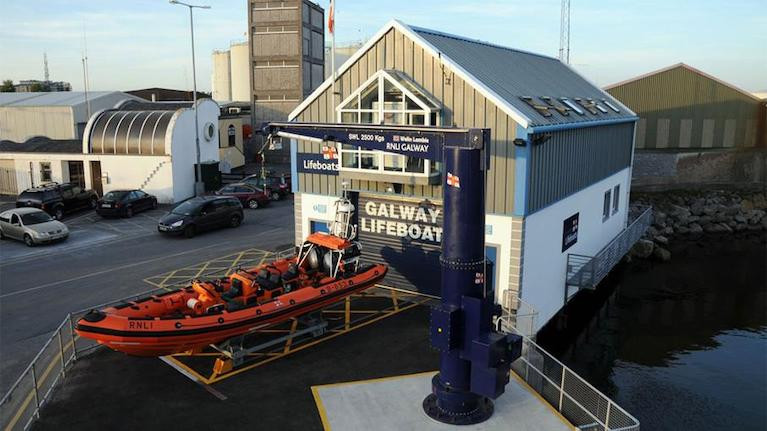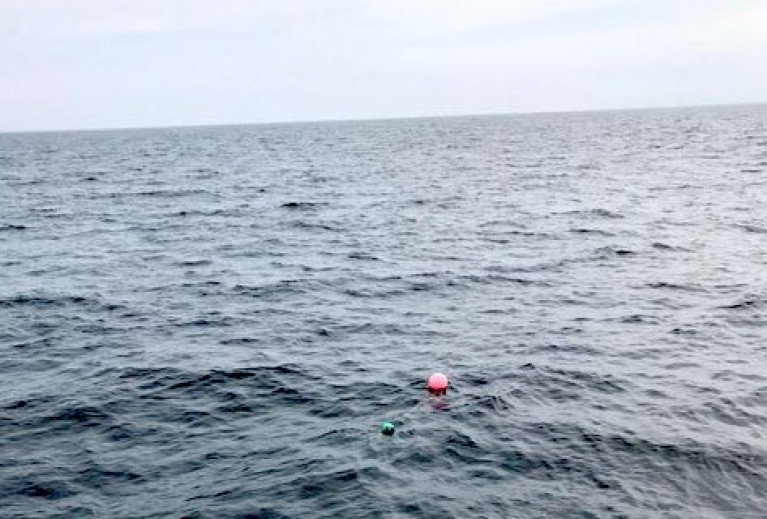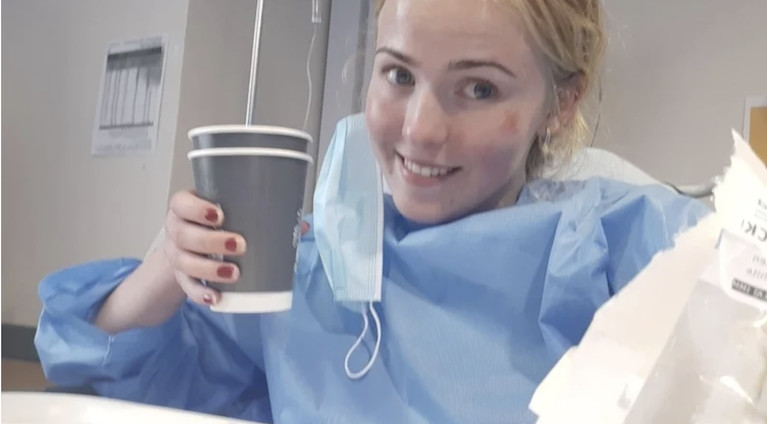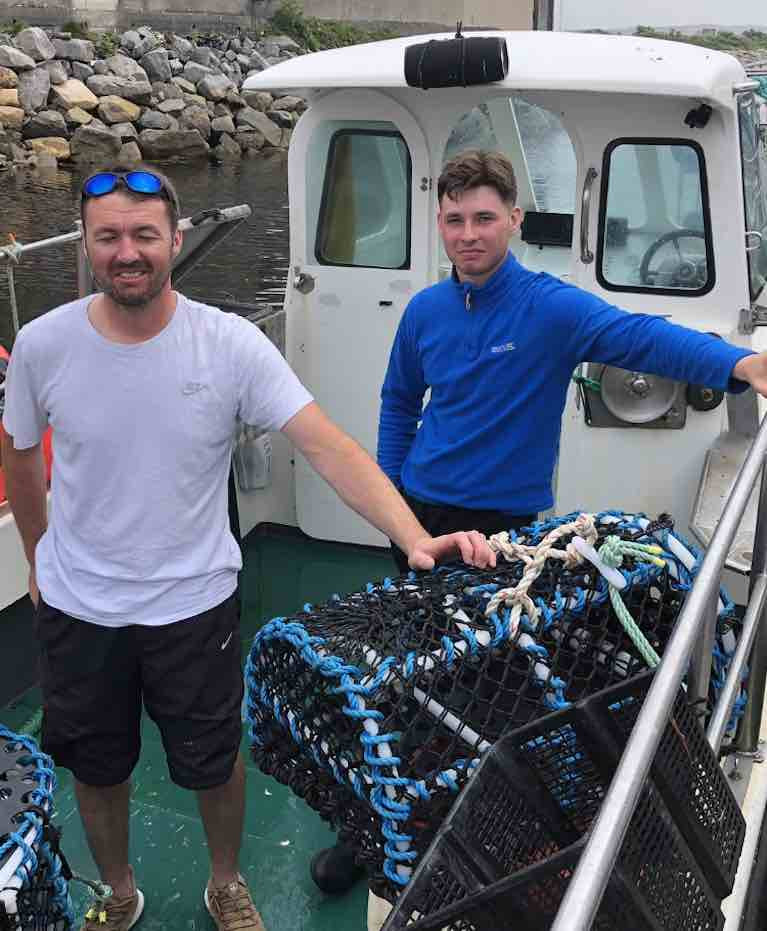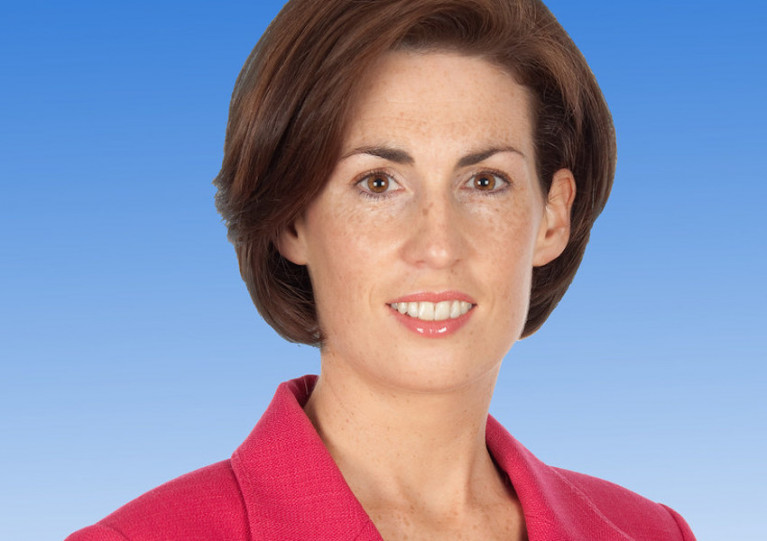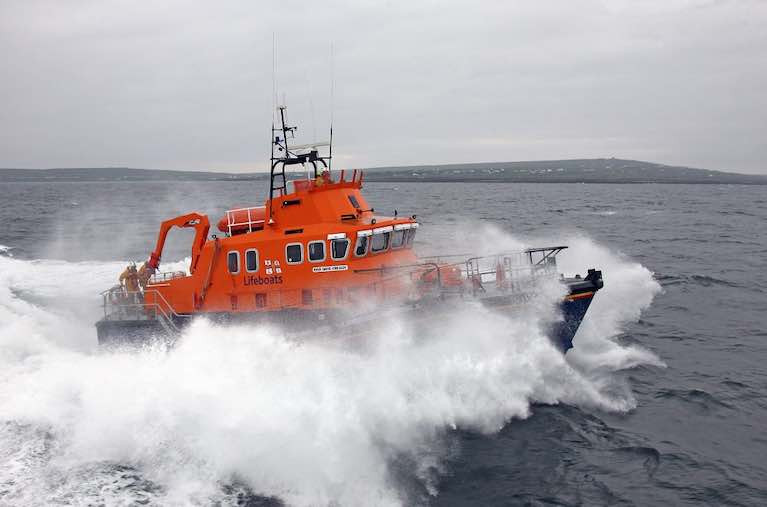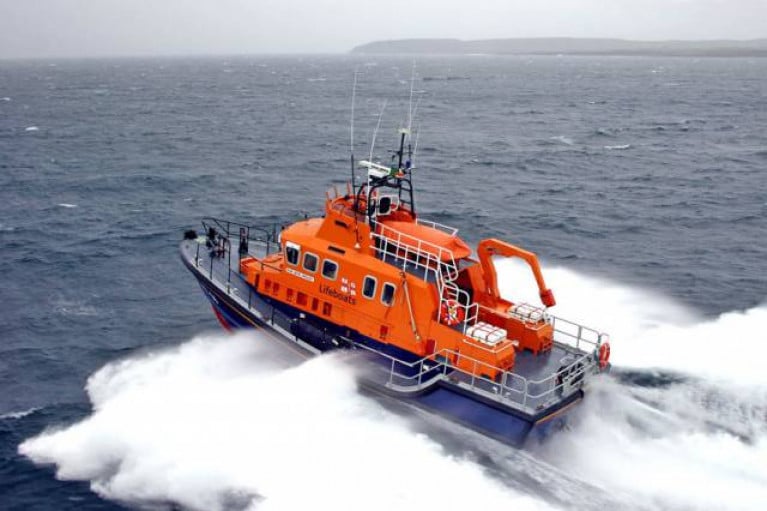Displaying items by tag: Galway Bay
Galway Paddleboarder Issues Water Safety Appeal & Pays Tribute to Those Involved in Sea Rescue
Sara Feeney, the Galway woman who survived 15 hours at sea on paddleboards with her cousin Ellen Glynn, has paid a further tribute to those involved in rescue at sea.
In an interview with RTE Radio 1 Countrywide, she has also appealed to water users to wear a buoyancy aid, to always have a means of communication and to carry a light.
“We owe it to these people to do everything we can to keep ourselves safe,” she said, describing all those involved in rescue on water as “heroes”.
“Lifejackets are a must, there’s no question about it..and even things like a light,” she said. “It is very easy to have a waterproof pouch with you where you can have these things,” she said.
Vessels & a helicopter close by
Ms Feeney described her overnight ordeal in heavy rain, thunder and lightning with her cousin, and how there were times when it felt as if there were vessels and a helicopter close by.
She also described her own concern when they hadn’t been found after being carried by north-easterly winds across the bay from Furbo to south of the Aran island of Inis Oírr – a distance of 17 nautical miles.
Floats attached to crab gear
The floats attached to crab gear owned by fisherman Bertie Donohue off Inis Oírr had probably “saved them” from being swept out into the Atlantic, but she said she also had a sense that perhaps the search pattern had changed to a shore search.
“It was terrifying to have those thoughts...,” she said, explaining how she feared their those searching for them had “assumed a certain outcome at this point”.
Speaking about their ability to stay calm, she said that being together was crucial.
“I don’t know if Ellen’s age I would have had or had seen so many horror stories about water...Ellen probably was and had total understanding of what was going on, but neither of us really communicated that to each other... we didn’t really say that out loud at the time,” she said.
“If we had started talking like that, it was just another level of hopelessness we didn’t need,” she said.
“I wouldn’t have been able to hold it together if she [Ellen] had been in a state of panic,” she said, describing their unspoken joint decision to keep calm.
A “huge thing on her mind” during the night, particularly after each vessel and helicopter flight which didn’t see them, was that “nobody gets out of this situation...”
“Lots of people don’t get the ending that we did in that situation..so that’s definitely on your mind the whole time,” she said.
Patrick and Morgan Oliver
Patrick and Morgan Oliver of the Claddagh seafaring family, who rescued them in their seven-metre catamaran Johnny Ó, were “wonderful”, she said.
“When you are out there you are thinking that all of these people are out there looking, and you have it in your head that if they do find you ...you are going to be in some sort of trouble...the stress and everything that you cause people...but they were just so kind, the instant we were on the boat just feeling so safe,” she said.
“The fact that there was such a happy ending to this is something we can take from it,” Ms Feeney said.
“These people who go out and take time out of their own lives without hesitating and put their own safety at risk to look for people that they don’t know...are heroes.”
“Everyone we met along the way was so kind and helpful...it was lovely,” she said.
Hear the extended RTE Radio Countrywide interview here
RNLI Galway Lifeboat Rescues Kitesurfer in Inner Galway Bay
Galway RNLI lifeboat has rescued a kite surfer who got into difficulty in inner Galway Bay on Saturday evening.
The man, who is in his early thirties, had set off from Ballyloughane beach near Renmore at about 4.50 pm as the tide was going out. A north-westerly breeze of force three to four was blowing at the time, and the man came off his board a number of times.
He was very fatigued when he was blown onto Rabbit Island, and the alarm was raised by a member of the public at 5 pm.
The Irish Coastguard tasked the Galway RNLI inshore lifeboat, and the man was rescued at about 5.20 pm. He was wearing a wetsuit, but not a lifejacket, according to Galway RNLI.
RNLI Galway deputy launch authority, Mike Cummins, said that a key factor when taking to the water for any water sports activities is a “knowledge of the local tides and wind direction”.
The RNLI Galway volunteer crew on the callout were helmsman Declan Killilea, crew Brian Niland, Joanne Casserly and David McGrath, and shore crew Sean King and David Oliver.
Aran Fisherman Who Owns Pots at Centre of Paddleboard Rescue Praises "Two Very Tough, Very Brave" Women
Aran island fisherman Bertie Donohue says he is “amazed” at the resilience of the two young Galway women who survived a 15-hour ordeal after their paddleboards were swept across Galway bay last week.
“They are two very tough, very brave girls – and I don’t know how they managed to hold on to my fishing gear in that location,” the crab fisherman from Cill Éinne on Inis Mór says.
When he heard that Sara Feeney (23) and Ellen Glynn (17) had secured themselves to floats off the Aran island of Inis Oírr, after being carried across the bay last Wednesday night, he knew immediately this was his crab gear.
 Aran fisherman Bertie Donohue and the sling that Ellen Glynn and Sara Feeney secured boards to
Aran fisherman Bertie Donohue and the sling that Ellen Glynn and Sara Feeney secured boards to
The fisherman, who processes brown crab on Inis Mór, said he had planned to move the gear early last week, but said: “something stopped him”.
 Bertie's boat named Venture
Bertie's boat named Venture
“That was one of three sets of pots I laid off “The Finish”, some two-miles south-west of Inis Oírr, but it was the outer set of gear,” he said.
“If they had missed it, they would be out in the Atlantic,” he said.
 The chart area
The chart area
Mr Donohue said that “what had happened to those two girls could happen to any of us”.
He said their own ability to keep calm had been key to their survival – along with their rescue by fishermen Patrick and Morgan Oliver of Galway RNLI.
When the two exhausted women fully realised their location after fog lifted last Thursday morning, the Cliffs of Moher were just south of them and the wide Atlantic just west.
The 20 knot north-easterly had carried them diagonally across Galway Bay towards Black Head, during a night of heavy rain and lightning.
Wearing only buoyancy aids over their swim togs, they tried to paddle up to Inis Oirr with the wind still against them.
It was at that point that they spotted the floats and grabbed hold of the gear, securing the sling through the webbing on the boards.
They had already wisely lashed the two boards together when they were carried south-west of Furbo beach by the offshore wind.
“I don’t know how they survived that night as there was awful weather, and that north-easterly is cold and makes a very bad chop in the sea when you are away from shore,” Mr Donohue said.
“That is a very exposed location, and I only set the gear there to help another fisherman, who lost 200 pots last October when his boat sank in Inis Oírr,” he explained.
“And his boat sank in a north-easterly, the same wind those girls had, which just shows you how tough that weather is,”Mr Donohue said.
Mr Donohue lifted the pots at the weekend, and there was a good catch of crab.
The two women and their families, from Knocknacarra, Galway, have paid tribute to all those who participated in the search and the rescue, and have said they cannot thank the Olivers enough.
Three Irish Coast Guard helicopters, RNLI Aran and Galway lifeboats, Doolin and Costello Bay, Garda, the Civil Defence, local fishing and leisure craft, along with Galway Flying Club, Aer Arann and many volunteers had participated, and it was co-ordinated by Valentia Marine Rescue Sub-Centre.
Former Irish Coast Guard search and rescue pilot Dave Courtney, author of the memoir Nine Lives, says that questions need to be asked as to why the rescue took so long.
The Irish Coast Guard has said the search for the two women covered a 200 square mile sea area.
It said it was using SARMAP - the US software used effectively by Valentia Coast Guard in 2011 to track the probable location of the crew of the yacht Rambler which capsized in the Fastnet yacht race off West Cork.
“ The search was just moving into the south-west of the Inis Oirr sector ...with both aviation and surface assets when the fishing vessel Johnny Ó came upon them. It is highly likely they would have been detected within the following one to two hours as it was daylight,”it says.
Shooting Stars & Taylor Swift Lyrics: Ellen Glynn on Sustaining Spirits During an Overnight Ordeal in Galway Bay
Taylor Swift songs and shooting stars sustained cousins Ellen Glynn (17) and Sara Feeney (23) during their 15-hour overnight ordeal on paddleboards in Galway Bay.
“I think I know every line of Taylor Swift – we sang them all,” Ellen told The Irish Examiner, speaking from her ward in University Hospital Galway yesterday.
“What I would really like to do is to thank the hundreds of people who came out on boats, planes, in helicopters, on foot, and said prayers and lit candles and raised the alarm on social media,” she said.
Describing how she and her cousin kept their cool during the long hours of darkness, she recalled how she sang every Taylor Swift song she knew.
They saw a meteor shower of shooting stars, they kept memorising the lights of Furbo and Spiddal on the exposed northerly shore for as long as they could see them, and “we would each talk about what we’d do when we get home”.
Ellen said that both a helicopter and a vessel were close enough to light up the sea around them, at one point.
There was lightning and heavy rain, and waves became bigger and they were “shivering uncontrollably”, she said.
When sun rose, visibility was poor – but as the fog lifted, they realised just how far they had been swept, with the Cliffs of Mother just south of them, the Aran island of Inis Oirr to the north, and the Atlantic to the west.
“I had thought we were being carried into Galway, but we were being swept in the opposite direction,” she said.
When Patrick Oliver and his son Morgan located them on their seven-metre Johnny O at around midday on Thursday, some two to three nautical miles south-west of Inis Oírr, Ellen says they told the two men they thought “no one was looking for them”.
“And they said ‘do you know how many people are out looking for you’”, she laughed.
More in The Irish Examiner here
Patrick & Morgan Oliver of Galway's Claddagh Get Afloat.ie National Seamanship Award
It says everything about the announcement that Patrick Oliver of The Claddagh in Galway and his son Morgan are to receive the Afloat.ie National Seamanship Trophy with immediate effect, when we realise that everyone in the country will know exactly what it's for without any further explanation.
Their brilliant rescue on Thursday of two paddle-boarders, who had been blown right across Galway Bay overnight in strong to gale force nor'easters, such that they were 17 sea miles from their start-point in Connemara at Furbo Beach, and south of the Aran Islands, involved genius-level detailed navigational and sea and wind calculations.
 When the Olivers set off on their search, they went directly from Galway to Black Head in northwest Clare, and then southwest leaving Inish Oirr to starboard. Map by Irish Times
When the Olivers set off on their search, they went directly from Galway to Black Head in northwest Clare, and then southwest leaving Inish Oirr to starboard. Map by Irish Times
The last time we made a similar immediate award was jointly with Irish Sailing three years ago in August 2017, when Simon Hoffman of Australia, and Santiago Alegre of Spain, succeeded in a heroic rescue of Cork's Johnny Durcan when he had been completely trapped and was in danger of drowning under his capsized 29er during a major championship in California.
The Hoffman-Alegre award was for bravery, as both sailors had to dive under the 29er's sails and haul Johnny underwater through ropes and other clutter to save his life. But in this instance, as there's no sailing involved, Afloat.ie are going it alone. And as Patrick and Morgan were not themselves in personal danger, the award is for Seamanship.
But what Seamanship it is…..it cannot be said often enough that it has been an instance of completely brilliant seamanship up to the point of genius. The Oliver family are "Claddagh Fishing Royalty", with a flotilla of fishing boats – "too many", they quip - for various purposes. But as Patrick (40) and his son Morgan (18) absorbed the news of the lack of success in the increasingly grim search in Galway Bay on Wednesday night, they set to work ashore, analyzing the way the tides would have been running, and the effect the almost freakish winds – gale force at times – would have affected surface drift.
Then first thing Thursday morning, the pair of them set off in their "little speedboat", a 7 metre Cheetah Class catamaran powered with "two enormous outboards". This is an outfit which they acquired from Kilmore Quay in Wexford, a port where they also know a thing or two about fast lobster and crab fishing boats.
Thus while other craft were combing Galway Bay in an increasingly despairing search pattern, the Oliver team streaked straight down the Bay at 20 knots and then on out of the Bay, only beginning their searching – and in a focused southwesterly direction at that – once they'd got well past Black Head, the imposing northwest headland of County Clare.
 The fastest lobster boat in the west? Patrick and Morgan Oliver's 7-metre Cheetah Class is well able to reach 20 knots. They sourced this special machine in Kilmore Quay in County Wexford. Photo: Pierce Purcell
The fastest lobster boat in the west? Patrick and Morgan Oliver's 7-metre Cheetah Class is well able to reach 20 knots. They sourced this special machine in Kilmore Quay in County Wexford. Photo: Pierce Purcell
With calculations now in overdrive, they were two miles south of Inish Oirr – the most easterly of the Aran Islands – with the unforgiving Cliffs of Moher the nearest bit of the mainland, when Morgan's eagle-eyes spotted the two women paddle-boarders – still with their boards - attached as best they could to a lobster pot marker.
Patrick and Morgan have nothing but praise for the calmness and resilience of Sara Feeney (23) and her cousin Ellen Glynn (17) in coming through their 15 hours-plus nightmare.
It had started with a freakishly warm and calm evening in Furbo, with the sea temperature at the beach - as we reported in Afloat.ie – at 19 degrees centigrade. It was so calm and quiet that the two paddleboarders could make their way gently along the shoreline, chatting with those on the sand.
But then the underlying new gradient wind from the nor'east started to make its catspaws on the water as dusk set in, and with the cooling effect of the evening, the land temperatures fell much more quickly than the warm sea, rapidly accelerating the now combined gradient wind and this growing wind off the land, which in turn gained further power from building thunderstorms.
 Patrick Oliver and his son Morgan, who rescued cousins Ellen Glynn and Sara Feeney off Inis Oirr island, with some of Patrick’s RNLI colleagues on their arrival back at the Galway RNLI Lifeboat Station at Galway Docks. Photograph: Joe O’Shaughnessy
Patrick Oliver and his son Morgan, who rescued cousins Ellen Glynn and Sara Feeney off Inis Oirr island, with some of Patrick’s RNLI colleagues on their arrival back at the Galway RNLI Lifeboat Station at Galway Docks. Photograph: Joe O’Shaughnessy
In an incredibly short time as night fell, the scene was transformed, and the two paddleboarders found themselves being blown out into the lightning-pierced darkness in a near gale. While they both had lifejackets, neither wore a wetsuit, so despite the warm sea, there was a growing risk of hypothermia.
But despair would have been their greatest enemy had they allowed it to take over, so they lashed their paddleboards together using the little painter lines, and kept each other's spirits up by singing and chat, while if one felt sleep coming on, the other let her have a nap while keeping a lookout and a watch on her cousin.
They were in the Atlantic by the time dawn came on, having passed almost exactly midway between Inish Oirr and Clare. But with the light of the new day, they spotted the pot-marker which was to be their saving, and though both painter ropes were already being used to keep the paddleboards together as a sort of life-saving raft, they were able to utilise the side-webbing on the boards to create an atttachment to the pot-marker line - they weren't "clinging on" as initial reports suggested.
And there they waited, in the middle of nowhere with the Atlantic swell for company, until the genius in reading the ways of the sea of Patrick and Morgan Oliver in their little 22ft "lobster speedster" arrived on almost a straight line from Black Head to scoop them up.
There'll have been some shrewd offshore racing campaigners who, when they heard just how accurately this remarkable father-and-son crew calculated precisely where the paddleboarders would be, might understandably have got to thinking that there's the making of an astonishing offshore racing tactical team here.
 Job done. Patrick (who has served with the Galway lifeboat) and Morgan Oliver return with their very efficient rescue vessel to Galway Port, accompanied by the Galway Lifeboat. Photo: Galway RNLI
Job done. Patrick (who has served with the Galway lifeboat) and Morgan Oliver return with their very efficient rescue vessel to Galway Port, accompanied by the Galway Lifeboat. Photo: Galway RNLI
But equally, there'll be HR managers in some high-powered organisations who will be impressed by the cool and calm and resilient way in which Sara and Ellen dealt with their appalling predicament. For sure, they'd made an awful mistake. But anyone who never made mistakes never made anything. It's how you handle the outcome that ultimately matters, so Sara and Ellen are two very special people.
And as for their rescuers, a simple award scarcely does justice to the achievement of Patrick and Morgan Oliver. But it's something we can do to mark the great joy they have brought to Ireland this weekend.
Salthill’s Blackrock Diving Tower reopened yesterday (Wednesday 12 August) with Galway city officials keeping a watchful eye after it was closed following reports of overcrowding, according the Connacht Tribune reports.
Access to the tower was barred on Tuesday amid social distancing fears as crowds made the most of the sunny weather to take a dip in the warming waters of Galway Bay — which may have also helped keep alive two paddle boarders rescued earlier today after 15 hours at sea.
A spokesperson said the council will continue to monitor crowds at the tower to ensure social distancing in the queue to the platform is maintained.
The Connacht Tribune has more on the story HERE.
Fishermen Rescue Paddle Boarders Who Spent 15 Hours at Sea
Following a major search and rescue operation on Galway Bay overnight and this morning (13 August 2020), two women have been found safe and well off Inis Oir after spending 15 hours out at sea.
Former Galway RNLI lifeboat crew member and current shore crew member and fisherman Patrick Oliver and his son Morgan joined the search early this morning and discovered the two women on their boards holding on to a lobster pot about two miles south west of Inis Oir.
Despite spending the night out on the water in extreme conditions, the women did not require medical attention. They had drifted almost 20 miles when discovered. They were taken onboard the fishing vessel, the Johnny O, and after disembarking, walked up the pier where they were medically assessed by Coast Guard personnel.
The 23-year-old woman and 17-year-old teenager who are cousins, had gone paddle boarding at about 9 o’clock last night from Furbo Beach when a sudden north wind blew them out to sea. A relative of the women raised the alarm and the Irish Coast Guard immediately launched a major search and rescue operation which continued throughout the night and today.
Galway RNLI launched its inshore lifeboat at 10pm (last night) and stayed out throughout the night changing crew three times. They were joined immediately by the Aran Island RNLI all-weather lifeboat and the Irish Coast Guard Rescue helicopter 115 from Shannon. Two further Coast Guard Rescue helicopters from Sligo and Waterford joined this morning, along with Coast Guard lifeboats from Oranmore/Maree, Cashla Bay and Doolin while the Civil Defence carried out a search along the north shore co-ordinated by the Gardai. Galway Flying Club and Aer Arann also joined the search.
There were scenes of jubilation and joy in both Galway and Aran Island RNLI Lifeboat stations when fisherman Patrick Oliver rang the Galway Lifeboat station with the good news.
Barry Heskin, Galway RNLI Deputy Launching Authority said the two women kept their heads and did the right thing: ‘We are absolutely delighted that it has all worked out well.’
Minister of State Hildegarde Naughton has praised the coastguard, Garda and local volunteers for their quick response in the rescue of two missing paddle boarders in Galway Bay today, Thursday 13 August.
As reported earlier on Afloat.ie, the two young women were found clinging to a lobster pot marker off Inis Oírr in the Aran Islands after a major overnight search and rescue operation.
Naughton, the Fine Gael TD for Galway West, said: “I would like to offer my sincere gratitude and thanks to all members of the Irish Coast Guard, An Garda Síochána and local volunteers who worked tirelessly overnight and this morning in the search for the two missing paddle boarders since the alarm was raised last night.
“Their quick thinking and bravery have resulted in the safe return of two young ladies to their families today.
“The appreciation of the work of our emergency services can be heard in the shared sigh of relief not just across Galway, but indeed nationwide, as the good news reached us this afternoon.
“Thankfully this most recent event has had a happy ending; however, it is imperative for us all to be vigilant of the sea and the elements as we enjoy our coastline during the fine weather.
“Just last month I launched the newly updated Safety on the Water website in collaboration between the coastguard, RNLI, Water Safety Ireland, Irish Sailing and BIM. I would invite everyone to familiarise themselves with the guidance that has been provided by those who know our waters the best by visiting www.safetyonthewater.gov.ie”
Miracle of Galway Bay as Missing Paddle Boarders Found Alive & Well
The two young women paddleboarders who went missing off Furbo on the northern shore of Galway Bay at 8 pm yesterday evening have been found alive and well clinging to a lobster pot marker off Inisheer, the most easterly of the Aran Islands.
As Afloat reported earlier, the pair were the subject of major search operation las night and this morning.
While the waters of the Bay are relatively warm this year, with 19 degrees centigrade being recorded close in off Furbo beach, it is nevertheless little short of miraculous that they should have survived for more than 16 hours, for although both were wearing lifejackets, neither was wearing a wetsuit.
More follows on this good news story on Afloat.ie.
Air Sea Search Underway for Two Missing Paddleboarders in Galway Bay
An extensive air and sea search is underway in Galway Bay after two young women who set out on stand-up paddleboards from Furbo last evening failed to return to shore.
The two women are aged 17 and 23 and from Galway, are believed to have left Furbo beach at around 8 pm on Wednesday.
The alarm was raised at 9 pm when they had not returned.
The women were wearing buoyancy aids, but not wetsuits. Sea conditions were calm but with an offshore north-westerly breeze.
The RNLI Aran island and Galway lifeboats, the Irish Coast Guard’s Shannon and Sligo-based helicopters and Doolin and Costello Coast Guards have been searching throughout the night for the two women, while local volunteers have also been combing the coastline.
Galway RNLI operations manager Mike Swan said that lifeboat crews combed the sea area throughout the night.
“The search area had focused on the inner Galway bay area and had extended west to Black Head,” he said.
Salthill Garda station is coordinating the search, working with the Irish Coast Guard and RNLI, and a meeting took place in Spiddal this morning.
The Marine Institute based in Oranmore has launched its rigid inflatable, along with a number of local craft, and the institute’s ocean sciences staff are also working on the tide and current modelling to assist the search crews.
Residents living close to the coast from Barna west to Spiddal have been asked to check the shoreline near their homes.
Update 11 am Thursday, August 13
Statement from the Irish Coast Guard on search operation for two missing females
The Irish Coast Guard Coordination centre at Valentia are currently coordinating an extensive search of Galway Bay after two females aged 17 and 23 who were paddleboarding at the time were reported overdue last night at 10:05 pm just off Furbough, Co. Galway. All available Air and Marine Rescue assets are currently being utilised in the search and the Coast Guard are liaising with An Garda Siochana at Salthill in an effort to locate the two missing females. Any sightings or information should be reported to the Coast Guard at MRSC Valentia on 112 or 999.




























